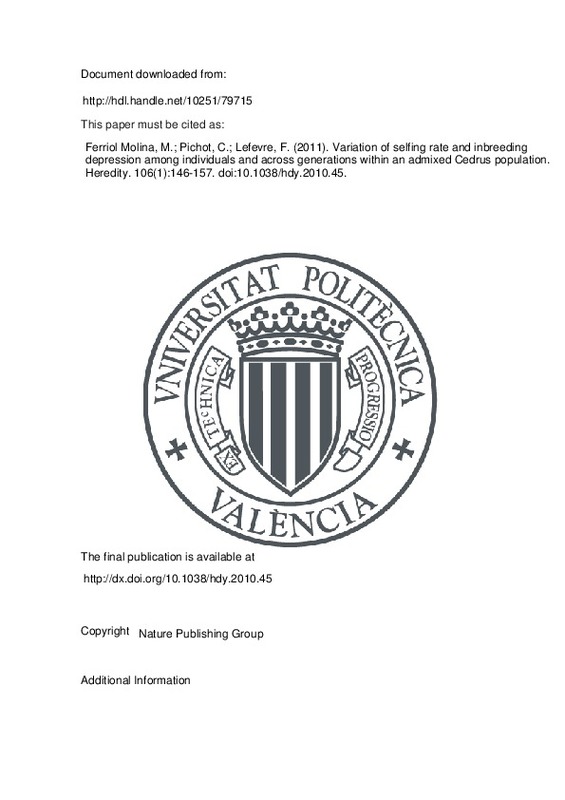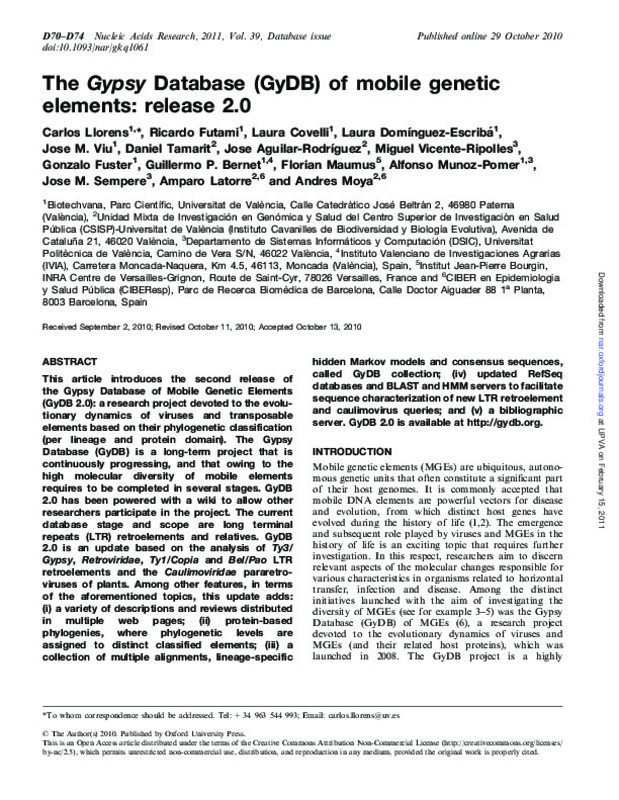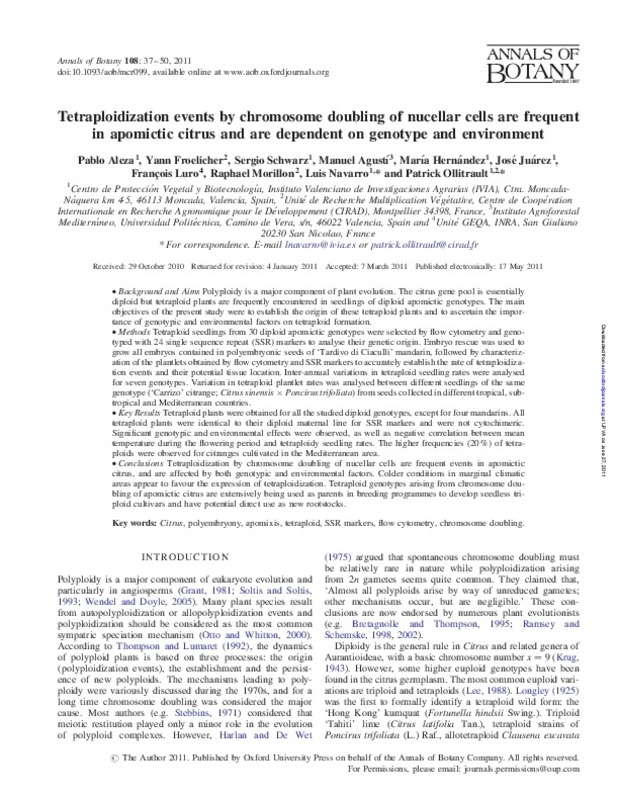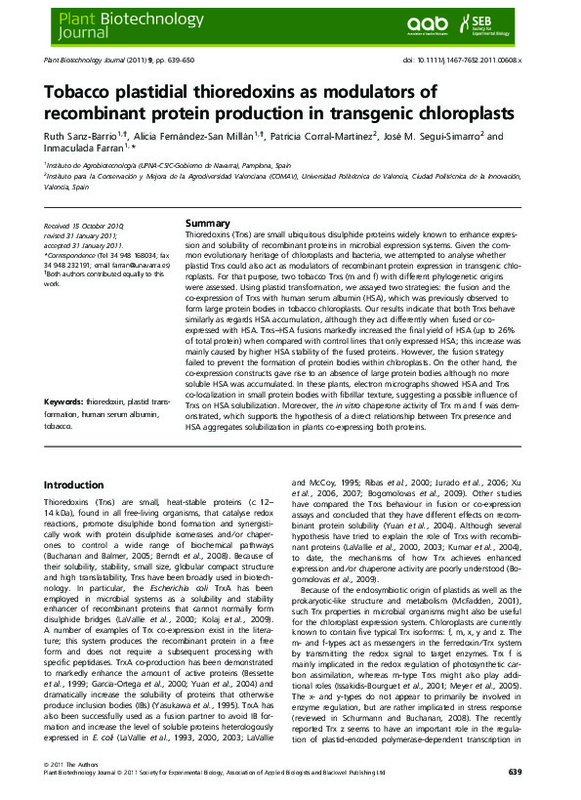Barret SH, Eckert CG (1990). Variation and evolution of mating systems in seed plants. In: Kawano S (ed). Biological Approaches and Evolutionary Trends in Plants. Academic Press: London. pp 230–254.
Benton TG, Plaistow SJ, Coulson TN (2006). Complex population dynamics and complex causation: devils, details and demography. Proc R Soc B Biol Sci 273: 1173–1181.
Bower AD, Aitken SN (2007). Mating system and inbreeding depression in whitebark pine (Pinus albicaulis Engelm.). Tree Genet Genomes 3: 379–388.
[+]
Barret SH, Eckert CG (1990). Variation and evolution of mating systems in seed plants. In: Kawano S (ed). Biological Approaches and Evolutionary Trends in Plants. Academic Press: London. pp 230–254.
Benton TG, Plaistow SJ, Coulson TN (2006). Complex population dynamics and complex causation: devils, details and demography. Proc R Soc B Biol Sci 273: 1173–1181.
Bower AD, Aitken SN (2007). Mating system and inbreeding depression in whitebark pine (Pinus albicaulis Engelm.). Tree Genet Genomes 3: 379–388.
Byers DL, Waller DM (1999). Do plant populations purge their genetic load? Effects of population size and mating history on inbreeding depression. Annu Rev Ecol Syst 30: 479–513.
Cointat M (1996). Le roman du cèdre. Revue Forestière Française 48: 503–526.
Collevatti RG, Grattapaglia D, Duvall J (2001). High resolution microsatellite based analysis of the mating system allows the detection of significant biparental inbreeding in Caryocar brasiliense, an endangered tropical tree species. Heredity 86: 60–67.
Cottrell JE, White IMS (1995). The use of isozyme genetic markers to estimate the rate of outcrossing in a Sitka pruce (Picea sitchensis (Bong.) Carr.) seed orchard in Scotland. New Forests 10: 111–122.
Coulson T, Benton TG, Lundberg P, Dall SRX, Kendall BE (2006). Putting evolutionary biology back in the ecological theatre: a demographic framework mapping genes to communities. Evol Ecol Res 8: 1155–1171.
Durel CE, Bertin P, Kremer A (1996). Relationship between inbreeding depression and inbreeding coefficient in maritime pine (Pinus pinaster). Theor Appl Genet 92: 347–356.
Eriksson E (2006). Thinning operations and their impact on biomass production in stands of Norway spruce and Scots pine. Biomass Bioenergy 30: 848–854.
Fady B, Lefèvre F, Reynaud M, Vendramin GG, Bou Dagher-Karrat M, Anzidei M et al. (2003). Gene flow among different taxonomic units: evidence from nuclear and cytoplasmic markers in Cedrus plantation forests. Theor Appl Genet 107: 1132–1138.
Farris MA, Mitton JB (1984). Population density, outcrossing rate, and heterozygote superiority in ponderosa pine. Evolution 38: 1151–1154.
Favre-Duchartre M (1970). Des Ovules Aux Graines. Monographie 8. Masson et Cie.: Paris.
Franklin EC (1969). Inbreeding Depression in Metrical Traits of Loblolly Pine (Pinus taeda L.) as a Result of Self-pollination. North Carolina State University: Raleigh, NC. Technical report No 40, School of Forest Resources.
Gregorius HR, Ziehe M, Ross MD (1987). Selection caused by self-fertilization I. Four measures of self-fertilization and their effects on fitness. Theor Popul Biol 31: 91–115.
Hamrick JL, Godt MJ (1989). Allozyme diversity in plant species. In: Brown AHD, Al Kahler MC, Weir BS (eds). Plant Population Genetics, Breeding, and Genetic Resources. Sinauer: Sunderland, MA. pp 43–63.
Holsinger KE (1991). Mass-action models of plant mating systems—the evolutionary stability of mixed mating systems. Am Nat 138: 606–622.
Husband BC, Schemske DW (1996). Evolution of the magnitude and timing of inbreeding depression in plants. Evolution 50: 54–70.
Jones FA, Hamrick JL, Peterson CJ, Squiers ER (2006). Inferring colonization history from analyses of spatial genetic structure within populations of Pinus strobus and Quercus rubra. Mol Ecol 15: 851–861.
Kärkkäinen K, Savolainen O (1993). The degree of early inbreeding depression determines the selfing rate at the seed stage: model and results from Pinus sylvestris (Scots pine). Heredity 71: 160–166.
Keller LF, Waller DM (2002). Inbreeding effects in wild populations. Trends Ecol Evol 17: 230–241.
Klein EK, Lavigne C, Gouyon PH (2006). Mixing of propagules from discrete sources at long distance: comparing an exponential tail to an exponential. BMC Ecol 6: 3.
Knowles P, Furnier GR, Aleksiuk MK, Perry DJ (1987). Significant levels of self-fertilization in natural populations of tamarack. Can J Bot 65: 1087–1091.
Koelewijn HP, Koski V, Savolainen O (1999). Magnitude and timing of inbreeding depression in Scots pine (Pinus sylvestris L.). Evolution 53: 758–768.
Kremer A (1994). Genetic diversity and phenotypic variability of forest trees. Genet Sel Evol 26: s105–s123.
Krouchi F, Derridj A, Lefèvre F (2004). Year and tree effect on reproductive organisation of Cedrus atlantica in a natural forest. For Ecol Manage 197: 181–189.
Lande R (1988). Genetics and demography in biological conservation. Science 241: 1455–1460.
Ledig FT (1986). Heterozygosity, heterosis, and fitness in outbreeding plants. In: Soulé ME (ed). Conservation Biology: the Science of Scarcity and Diversity. Sinauer Ass: Sunderland. pp 77–104.
Lee JK, Nordheim EV, Kang H (1996). Inference for lethal gene estimation with application in plants. Biometrics 52: 451–462.
Lefèvre F, Fady B, Fallour-Rubio D, Ghosn D, Bariteau M (2004). Impact of founder population, drift and selection on the genetic diversity of a recently translocated tree population. Heredity 93: 542–550.
Marquardt PE, Epperson BK (2004). Spatial and population genetic structure of microsatellites in white pine. Mol Ecol 13: 3305–3315.
Morgante M, Vendramin GG, Rossi P (1991). Effects of stand density on outcrossing rate in two Norway spruce (Picea abies) populations. Can J Bot 69: 2704–2708.
Mosseler A, Major JE, Simpson JD, Daigle B, Lange K, Park YS et al. (2000). Indicators of population viability in red spruce, Picea rubens. I. Reproductive traits and fecundity. Can J Bot 78: 928–940.
Naydenov KD, Tremblay FM, Alexandrov A, Fenton NJ (2005). Structure of Pinus sylvestris L. populations in Bulgaria revealed by chloroplast microsatellites and terpenes analysis : provenance tests. Biochem Syst Ecol 33: 1226–1245.
Neale DB, Adams WT (1985). The mating system in natural and shelterwood stands of Douglas-fir. Theor Appl Genet 71: 201–207.
Notivol E, Garcia-Gil MR, Alia R, Savolainen O (2007). Genetic variation of growth rhythm traits in the limits of a latitudinal cline in Scots pine. Can J For Res 37: 540–551.
O’Connell LM, Russell J, Ritland K (2004). Fine-scale estimation of outcrossing in western redcedar with microsatellite assay of bulked DNA. Heredity 93: 443–449.
Parducci L, Szmidt AE, Madaghiele A, Anzidei M, Vendramin GG (2001). Genetic variation at chloroplast microsatellites (CpSSRs) in Abies nebrodensis (Lojac.) Mattei and three neighboring Abies species. Theor Appl Genet 102: 733–740.
Parraguirre-Lezama C, Vargas-Hernández JJ, Ramirez-Vallejo P, Ramirez Herrera C (2004). Mating system in four natural populations of Pinus greggii Engelm. Agrociencia 38: 107–119.
Petit RJ, Hampe A (2006). Some evolutionary consequences of being a tree. Annu Rev Ecol Evol Syst 37: 187–214.
Pichot C, Bastien C, Courbet F, Demesure-Musch B, Dreyfus P, Fady B et al. (2006). Déterminants et conséquences de la qualité génétique des graines et semis lors de la phase initiale de régénération naturelle des peuplements forestiers. In: 6e Colloque National du BRG ; La Rochelle 2006/10/02-04. Les Actes du Bureau des Ressources Génétiques 6: 277–297.
Remington DL, O’Malley DM (2000a). Whole-genome characterization of embryonic stage inbreeding depression in a selfed loblolly pine family. Genetics 155: 337–348.
Remington DL, O’Malley DM (2000b). Evaluation of major genetic loci contributing to inbreeding depression for survival and early growth in a selfed family of Pinus taeda. Evolution 54: 1580–1589.
Restoux G, Silva DE, Sagnard F, Torre F, Klein E, Fady B (2008). Life at the margin: the mating system of Mediterranean conifers. Web Ecol 8: 94–102.
Ribeiro MM, Mariette S, Vendramin GG, Szmidt AE, Plomion C, Kremer A (2002). Comparison of genetic diversity estimates within and among populations of maritime pine using chloroplast simple-sequence repeat and amplified fragment length polymorphism data. Mol Ecol 11: 869–877.
Ritland K, El-Kassaby YA (1985). The nature of inbreeding in a seed orchard of Douglas fir as shown by an efficient multi-locus model. Theor Appl Genet 71: 375–384.
Ritland K, Travis S (2004). Inferences involving individual coefficients of relatedness and inbreeding in natural populations of Abies. For Ecol Manage 197: 171–180.
Robledo-Arnuncio JJ, Alia R, Gil L (2004). Increased selfing and correlated paternity in a small population of a predominantly outcrossing conifer, Pinus sylvestris. Mol Ecol 13: 2567–2577.
Rouault G, Turgeon J, Candau JN, Roques A, Aderkas P (2004). Oviposition strategies of conifer seed chalcids in relation to host phenology. Naturwissenschaften 91: 472–480.
Savolainen O, Kärkkäinen K, Kuittinen H (1992). Estimating numbers of embryonic lethals in conifers. Heredity 69: 308–314.
Scofield DG, Schultz ST (2006). Mitosis, stature and evolution of plant mating systems: low-Phi and high-Phi plants. Proc R Soc B Biol Sci 273: 275–282.
Shaw DV, Allard RW (1982). Estimation of outcrossing rates in douglas-fir using isoenzyme markers. Theor Appl Genet 62: 113–120.
Skrøppa T (1996). Diallel crosses in Picea abies. II. Performance and inbreeding depression of selfed families. For Genet 3: 69–79.
Sorensen FC (1997). Effects of sib mating and wind pollination on nursery seedling size, growth components, and phenology of Douglas-fir seed-orchard progenies. Can J For Res 27: 557–566.
Sorensen FC (1999). Relationship between self-fertility, allocation of growth, and inbreeding depression in three coniferous species. Evolution 53: 417–425.
Sorensen FC (2001). Effect of population outcrossing rate on inbreeding depression in Pinus contorta var. murrayana seedlings. Scand J For Res 16: 391–403.
Sorensen FC, Adams WT (1993). Self fertility and natural selfing in three Oregon Cascade populations of lodgepole pine. In: Lindgren D (ed). Pinus contorta—From Untamed Forest to Domesticated Crop. Department of Forest Genetics and Plant Physiology, Sweden University of Agricultural Science: Umea, Sweden. Report 11, pp 358–374.
Sorensen FC, Miles RS (1974). Self-pollination effects on Douglas fir and ponderosa pine seeds and seedlings. Silvae Genet 23: 135–138.
Sorensen FC, Miles RS (1982). Inbreeding depression in height, height growth, and survival of Douglas-fir, ponderosa pine, and noble fir to 10 years of age. For Sci 28: 283–292.
Terrab A, Paun O, Talavera S, Tremetsberger K, Arista M, Stuessy TF (2006). Genetic diversity and population structure in natural populations of Moroccan Atlas cedar (Cedrus atlantica; Pinaceae) determined with cpSSR markers. Am J Bot 93: 1274–1280.
Vendramin GG, Lelli L, Rossi P, Morgante M (1996). A set of primers for the amplification of 20 chloroplast microsatellites in Pinaceae. Mol Ecol 5: 595–598.
White TL, Adams WT, Neale DB (2007). Forest Genetics. CABI Publisher: Cambridge, MA. pp 149–186.
Wilcox MD (1983). Inbreeding depression and genetic variances estimated from self- and cross- pollinated families of Pinus radiata. Silvae Genet 32: 89–96.
Williams CG (2007). Re-thinking the embryo lethal system within the Pinaceae. Can J Bot 85: 667–677.
Williams CG (2008). Selfed embryo death in Pinus taeda: a phenotypic profile. New Phytol 178: 210–222.
Williams CG, Auckland LD, Reynolds MM, Leach KA (2003). Overdominant lethals as part of the conifer embryo lethal system. Heredity 91: 584–592.
Wilson R (1923). Life history of Cedrus atlantica. Bot Gaz 75: 203–208.
Yazdani R, Muona O, Rudin D, Szmidt AE (1985). Genetic structure of a Pinus sylvestris L. seed-tree stand and naturally regenerated understory. For Sci 31: 430–436.
[-]







![[Cerrado]](/themes/UPV/images/candado.png)





